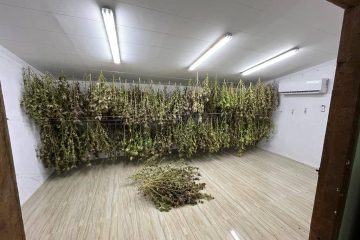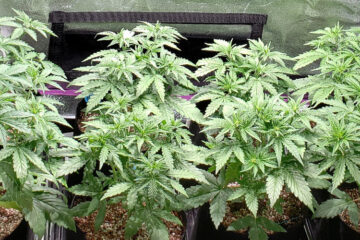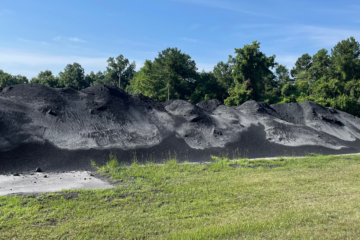Most marijuana growers are familiar with the terms ‘mixed-gender’ or ‘hermaphrodite’ plants, what causes them to develop, and how to avoid them in the garden. In this article, we’ll teach you what signs to look out for.
Whether you’re a new grower or a seasoned harvester, learning about hermaphrodites and other mixed-gender plants is not only an interesting phenomenon to observe, but an important part of any grower’s knowledege and education. Recognizing the development of potential mixed-gender plants and what causes them will ensure a better harvest, also this is a “Genetic Trait. This genetic trait of Hermaphroditism has ruined most all of the Cannabis I have seen in Asia.
Nearly all animal species are produced from one male and one female parent—and their offspring can, in turn, produce either gender. Cannabis Seeds are just the same: they are produced by one male and one female parent and are capable of growing into either a male or female plant. (Diacious). It is impossible to determine which plant gender a cannabis seed will produce; however, once a seed enters the ‘flowering stage’ it becomes quite simple to indentify its “sex” after approximately two weeks.
Occasionally—and under certain circumstances—a plant will develop traits of both genders, exhibiting male and female characteristics. This is known as hermaphroditism—an undesirable element in any marijuana crop.
Another mixed-gender occurrence is known as ‘bananas’ (or ‘nanners’). Bananas are exposed male pollen sacs (stamen) that begin growing from a female plant that has been exposed to stress, or this can be “induced” in the process of making Feminized Seeds or through “Rodelization”.
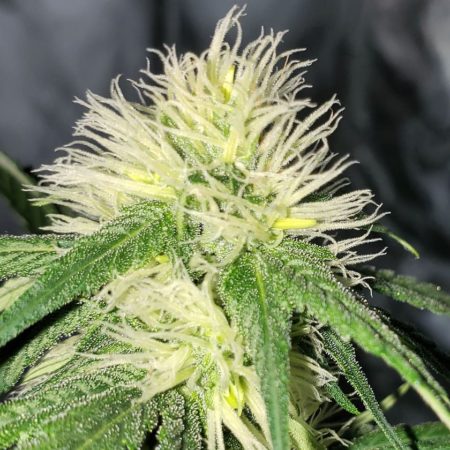
These sacs—normally located on the male plant—are typically encased in a protective layer containing pollen and are not exposed until it is time for them to burst.
Let’s examine the growth stages of cannabis plants more closely in order to understand when, where, why, and how hermaphrodite and mixed-gender plants develop and how to avoid them.
NOTE:
Latitude and Temperature
Generally speaking, the greater your latitude the cooler it is. The equator has the hottest areas on Earth because the equator receives the most direct sunlight all year long. Because the Earth is roughly circular, the higher latitudes are further away from the sun and thus don’t receive as much sunlight as the equator. In addition, the Earth has an atmosphere that buffers the heat of the sun’s rays. Sunlight has to travel further through the atmosphere at the poles than it does at the equator because of the angle of incidence of the curved surface of the earth.
Sunlight loses energy bouncing off the molecules in the atmosphere, so it heats the surface of the planet less at the poles than at the equator. With higher temperatures, plants have adapted to using less water during the day or they would wilt in the higher heats. In northern climates, plants have developed strategies to maximize daylight hours for photosynthesis and using nighttime to respire. Photosynthesis, like most chemical processes, advances faster in warmer temperatures so plants have to adapt to reduced growth in colder climates.
Latitude and Seasons
Because of the Earth’s angle of rotation in respect to the sun, the Earth has seasons. When the northern hemisphere is leaning toward the sun, it’s summer here. When the rotation of the Earth moves it so that the southern hemisphere is leaning toward the sun, it’s summer in the southern hemisphere. The change of season causes the temperatures further from the equator to change greatly. In some areas, the temperature can reach 100 degrees Fahrenheit (Thailand) in the summer and minus 20 degrees Fahrenheit in the winter (Not Thailand!).
The temperature at the equator also changes during the year because of rainy seasons that cool the land temperatures but not as much as at higher latitudes. Plants have to adapt to these temperature variations. Some plants sleep through the winter, such as deciduous trees that lose their leaves and herbaceous perennials that die back to ground level, while others, such as conifers, reduce their activities but continue to photosynthesize. Some plants have learned to create a bit of antifreeze in their cells to allow them to survive the seasonal temperatures without freezing.
Altitude and Temperatures
Plants are well adapted for where they live. Plants that live at higher altitudes have to adapt to colder temperatures. This is one reason it is important to have the Correct Strains for Thailand. Because the summer season at higher altitudes is so short, annuals have a big advantage, growing, flowering and setting seed in a few weeks. In Hawaii it was always around 80 Degrees. So we grew up where the coffee grew. Approx 2000 ft above sea level was Great! Deciduous trees can’t survive at high altitudes because the summer is too short to allow them to grow leaves and store enough energy to survive the longer winters.
Altitude and Drying
For plants that live at higher altitudes, preventing water loss is a big challenge. Higher altitudes have lower humidity levels, meaning that water loss is naturally greater and there is less rainfall meaning there is less water available for replacement. Alot of Plants at this altitude would have a “waxy” coating on their Leaves to protect them from abient conditions. In addition, the wind at higher altitudes is a factor.
Successful high-altitude plants have developed strategies to help them reduce water loss, such as having a waxy coating on the surface of their leaves, called suberin, and having their stomata (in the Blog) in small divots of the leaf’s surface to reduce wind damage. Stomata are the pores in the plant’s surface that allows it to breathe and transport minerals from the roots to the leaves. (Stomata, Something you should educate your self about…)
Another way to reduce water loss is to stay small. Smaller plants that hug the ground don’t suffer from the wind as much. Even the evergreen trees at high altitudes are smaller. Deciduous tree leaves would lose too much water to allow them to survive at the highest altitudes. I use Large Fans on my Farms to increase Air Movement and Plant Transpiration (another thing a Grower should know about…)
Ok Back To the Grow!
Plant Growth Stages
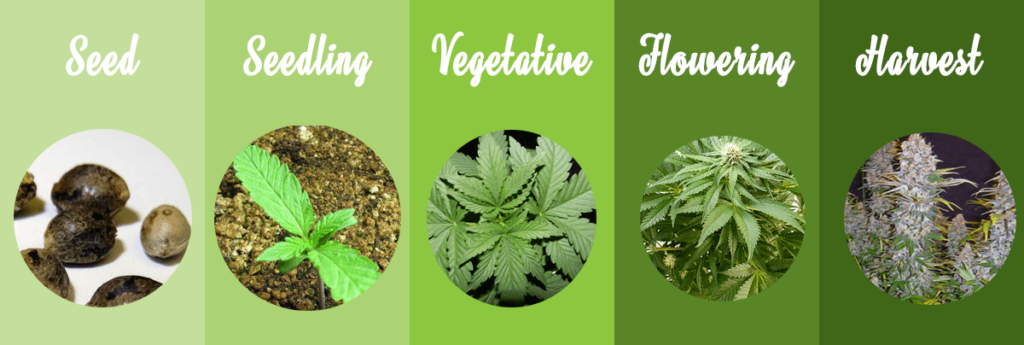
Seed Stage
The first stage of any future plant is the seed, of course. Cannabis seeds are available in regular, feminized, and auto-flowering types. Regular Seeds are just that: your regular, everyday cannabis plant seeds, capable of producing either male or female plants. Feminized Seeds have been developed specifically to eliminate male chromosomes, thus ensuring every plant in your crop will be female. I have an instructional Video on this Weppage on how to make your own Feminized Seeds.
Autoflowing Seeds do not require the strict light/dark ratio of hours in order to move from the vegetative stage to the flowering stage. They simply do so with age, and this means that they are usually ready to harvest within 10 weeks of planting and require the shortest flowering time. Living in Thailand in my opinion one does not need to purchase Auto-flowering Seeds, unless your growing indoors, . We live in a 12 hours of Sunlight and 12 Hours Darkness. Our Lat and Long = 17,41567, 102.78589
The vegetative cycle is when expansion takes place. The plant’s growth rate increases so the leaves can produce enough energy to continue to mature into a ‘tree.’ During this time, plants need all the sunlight and nutrients they can get. Their stems become stronger and thicker to support the new leaves and branches that are developing. The Plant will need to be strong in order to support the Flowers. Then it’s on to the next stage: “pre-flowering”.
Pre-flowering Stage
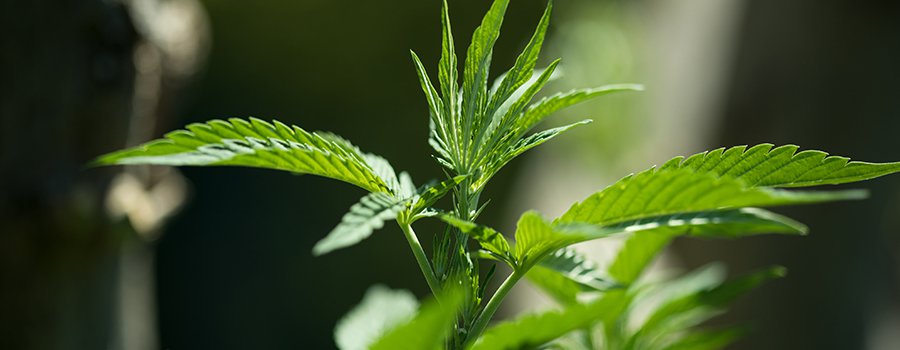
This stage takes anywhere from 2 weeks to 1 month, depending on the strain. During this time, the speed at which plants grow taller will begin to slow, while more branches and nodes develop, filling the plant out. You will notice the Stem in Female Plants will begin to be shorter and grow in a zig zag pattern. This is in preparation of the Flower Development. Or Where your “Bud” will be. Also this stage, a caylx (plant sepals forming a whorl around developing flower buds as a protective layer) will begin to appear where branches meet stems. Plant genders will be revealed in the next stage: “Flowering”.
Flowering Stage
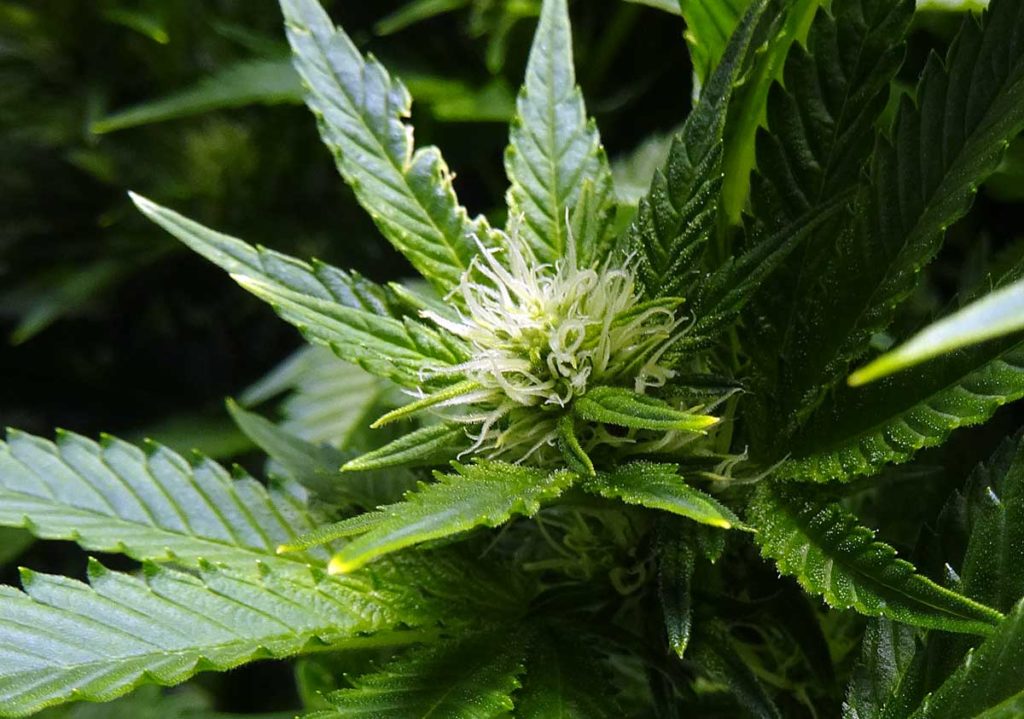
In this stage, plants will steadily become bushier and continue to fill out as they develop flowers. Approximately two weeks into the flowering stage, a plant will clearly reveal its gender. The flowers take anywhere from 2 to 4 weeks to fully develop. During the flowering stage, sacs containing pollen in male plants will burst to fertilize the female plants. Thus it is best to remove Males.
It is important to separate male and female plants as soon as their sex becomes apparent—unless, of course, you wish to produce and harvest cannabis seed. However this method will produce seeds of both Genders. While the male’s pollen is necessary to fertilize the female flowers, one or two male plants can produce a sufficient amount of pollen for a whole garden of females. Once pollinated, a female plant will focus its energy on producing more seeds instead of producing new flowers (buds), along with Resin, thus defeating the purpose of your crop. Reducing the CBD and THC Content of your Flowers.
Female plants begin to produce seeds once viable pollen is received from a male plant—these seeds take 1-2 months to to grow to full maturity. Plant gender is important because only female cannabis plants produce the desired outcome of any crop: buds. CBD or THC. Deny the Female Sex.
It is very important to pay close attention to your plants during the flowering stage as this is when the development of hermaphrodite plants and/or bananas is most likely to occur. It is crucial that you observe your plants’ development and avoid any fluctuation in environment or schedule in order to prevent inflicting any sort of stress on them—a primary cause in the development of mixed-gender plants.
Female Flowers and Characteristics
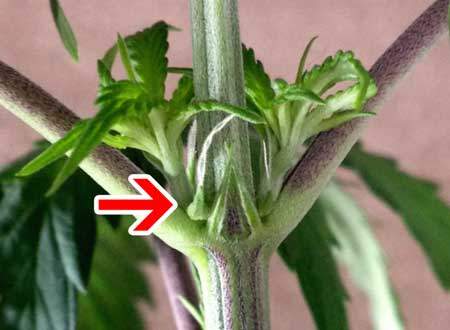
Female cannabis flowers consist of small, green seed pods with two small, white, fuzzy V-shaped hairs sticking out of them, called stigmas. Individual flowers grow to eventually form the dense clusters we know as ‘buds’. Female cannabis plants tend to be shorter and bushier than male plants. Woah! this is kinda the same with Lady Boys here in Thailand!! Outdoors, females will reveal themselves later than male plants (7 to 21 days), whereas indoor plants of either gender can usually be ‘sexed’ within 10 to 15 days.
Male Flowers and Characteristics
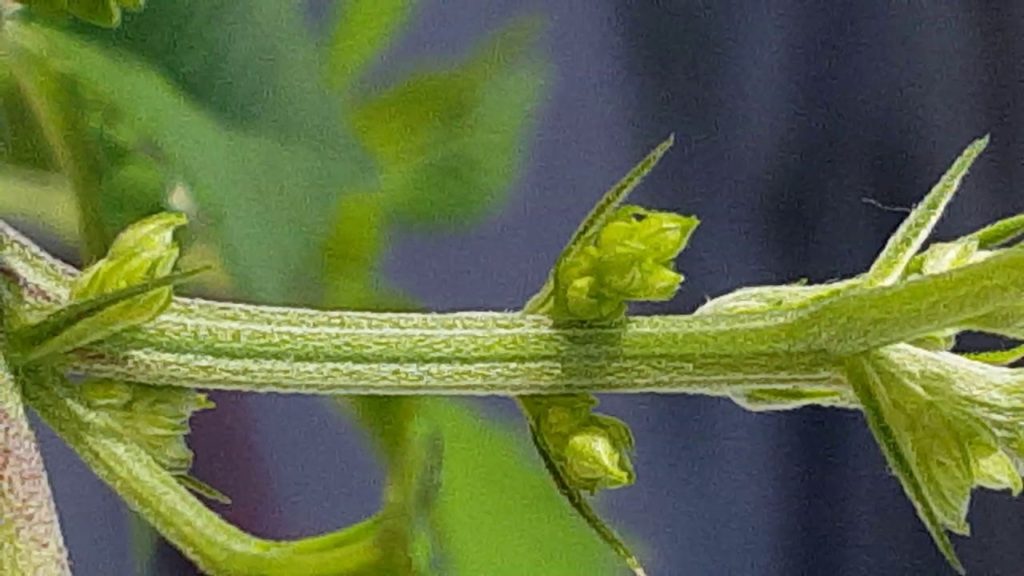
In the early stages of growth, male cannabis flowers develop tiny balls (or sacs) that resemble small bunches of grapes or bananas where pollen forms. The white hairs characteristic of the female plant will be absent. These sacs eventually open to release pollen and fertilize the female plants. Like mixed-gender and hermaphrodite plants, male plants are undesirable to harvest and best eliminated after their sex has been determined, but before their pollen is shed. I pull them up every day sometimes. My Chickens Love Them.
Male plants tend to be taller and have fewer leaves, looking a bit more straggly compared to females. Males typically begin to flower more readily than females (10 to 14 days) depending on the light cycle.
What Causes Hermaphrodite Plants to Develop?
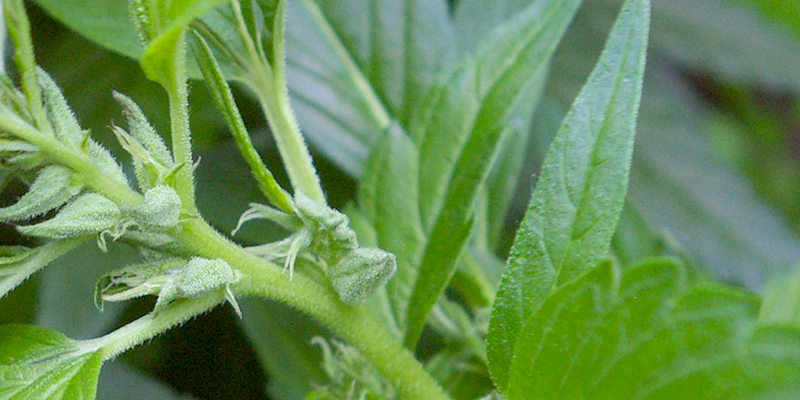
Plants have a natural survival instinct to ensure successful reproduction and continuation of the species. When growing conditions become harsh, plants recognize the likelihood of endurance is reduced—their survival mechanism is triggered in response. When this occurs, female plants will produce staminate (male) flowers so that they can self-pollinate and ensure survival.
By producing seeds without a true male flower, a plant will then produce the flowers of both sexes simultaneously resulting in hermaphroditism. This is an effective way for plants to adapt under the influence of certain environmental stressors by shortening their natural flowering period.
Maintaining a steady regimen for your plants is of the utmost importance in discouraging the development of undesirable mixed-gender plants. I immediately Pull Out all males and especially the Lady Boys ( Hermaphrodites )
What Causes Bananas to Develop?
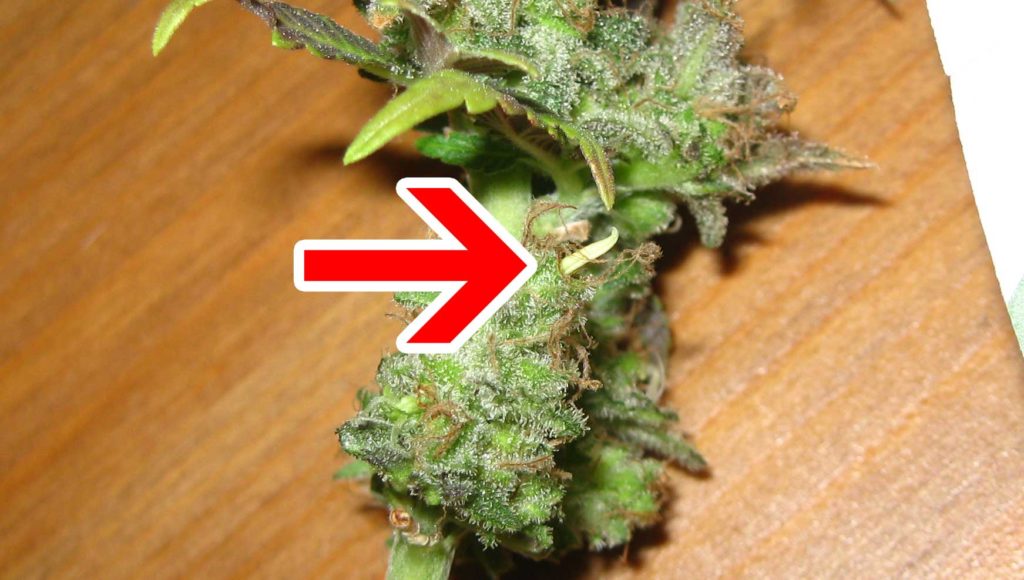
Another common mixed-gender plant is known as ‘bananas’—these are elongated, yellow pollen sacs that will grow from the centre of the buds on a distressed female plant. These often grow in clusters that resemble a bunch of bananas.
When bananas appear, they don’t necessarily burst in order to spread pollen as a regular pollen sac would. Bananas begin manufacturing pollen immediately and will seed nearby buds even if they are removed quickly after discovery—thus being more difficult to control than actual pollen sacs. If you notice excessive bananas among your crop, it may be best to harvest all plants immediately. I water and Care for each of my Plants individually, Yes this is Time consuming, yet this is my Job. This way I can spend a little time with each Girl and check/
Female plants that are allowed to grow too long past the ideal harvest time will sometimes produce bananas within their buds in an attempt to self-pollinate and create seeds for next year’s crop. This is not quite as destructive to a crop as hermaphroditism, as it occurs only after plants are past the point of optimum harvest.
Main Stressors That Result in Mixed-Gender Plant Development
- Inconsistent Light Schedule: For indoor grows, be sure to keep plant lights on a timer system and avoid changing the schedule if possible. For outdoor plants, be sure to prevent exposure to artificial light after sundown (such as flood lights, street lights, etc.)
- Respect the Dark: During flowering, it is important to make sure your plants receive a minimum of 12 hours of uninterrupted darkness each night (with the exception of auto-flowering strains). During this ‘dark period’ your plant is awaiting the return of sunlight; interrupting this process is a common stressor to plants and may even cause them to revert back to the vegetative stage. Equally important is the avoidance of light leaks!
- Light Burn: While generally more light is better for cannabis plants, very bright or hot lights (such as high-powered LEDS) can cause ‘light burn.’ This will stress your plants, cause bleaching, and possibly trigger hermie cannabis plants to develop. If your lights are too hot for your hands, then they’re too hot for your plants!
- Temperature: Be sure to maintain an even, comfortable temperature for your plants during the flowering stage—typically 18 to 29 degrees Celsius (65 to 85 degrees Fahrenheit) during the day, with slightly cooler temperatures at night.
- Genetics: Stress can play a major role in the development of both hermies and bananas—although genetics seems to affect the development of bananas more so. Growing seeds that were produced from a plant exhibiting hermie or banana traits are far more likely to produce the same traits as the parent plant.
- General Plant Health: Nutritional deficiencies, root rot, unbalanced soil pH, plant injury, etc. are all important factors that have the potential to trigger the development of mixed-gender marijuana plants.
Kevin

